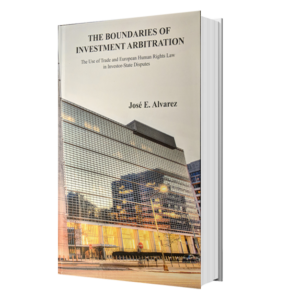The Use of Trade and European Human Rights Law in Investor-State Disputes
José E. Alvarez
In The Boundaries of Investment Arbitration, Professor José E. Alvarez analyses references to European human rights and WTO law in investor-state rulings, advances reasons for these resorts to “non-investment” law, and puts these “boundary crossings” in broader context. He enumerates the legal gateways for these “public law” references and considers what engagement with human rights and trade law tells us about the motivations of investor-state arbitrators, scholars, and civil society. Exploring when and how arbitrators or litigants reach into other international law regimes to interpret the content of international investment law says a great deal about what that law is—and is not.
Investment law practitioners are likely to find Alvarez’s enumeration of the many ISDS rulings that refer to trade or European human rights law (which are summarized in tables that identify the issues on which these references are considered relevant) useful in the course of litigation. Those concerned with contemporary debates over the future of the investment regime will be equally interested in whether such boundary crossings make international investment law more or less “fair,” “consistent,” or “legitimate.” More information is available on the publisher’s website.
Table of Contents
Chapter 1 – Introduction: Boundary Crossings and Why They Occur
- The Reality of Boundary Crossings
- The Entry Points for Trade/European Human Rights Boundary Crossings
- What Motivates Investor-State Arbitrators to Engage in Boundary Crossings?
- Scholars and Boundary Crossings
Chapter 2 – The Use (and Misuse) of European Human Rights Law by Investor-State Arbitrators
- Introduction
- A Survey of European Human Rights Citations in ISDS Case Law
- Why Is This Happening?
- A Case Study of Philip Morris v. Uruguay
- Tentative Conclusions
Chapter 3 – The Use (and Misuse) of Trade Law by Investor-State Arbitrators
- Introduction
- A Survey of Trade Law Citations in ISDS Case Law
- WTO References under NAFTA’s Chapter Eleven
- WTO References Beyond the NAFTA
- How Much “Trade-Infused” Investment Law Is There?
Chapter 4 – The Promise and Hazards of “Public Law” Boundary Crossings
- Introduction
- Comparing European Human Rights and WTO References
- When Are ECHR or WTO Boundary Crossings Appropriate?
- Do Boundary Crossings Matter?
- Conclusion



